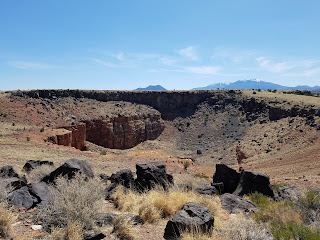Cities of Gold: A Journey Across the American Southwest in Pursuit of Coronado
© 1992 Douglas Preston (Walter Nelson, Photographs)
480 pages

Sometimes, history has got to be pursued from the back of a horse. Douglas Preston wasn't sure what took him to New Mexico -- he had a nice life in Manhattan before he abruptly decided to move to Santa Fe, to see the adobes washed in red sunlight -- but it took him further still, to the border of Arizona and Mexico. There, along with a friend and a hired horse wrangler, he purposed to re-create the journey of Francisco Vázquez de Coronado, the first Spainard to explore the Southwest. They would discover the Four Corners as the Spanish did, on horseback -- carrying their own supplies, following the water. Their mission -- to search what it might have been like to enter into these enormous spaces for the first time, and travel through them to the seven cities of Cibola. Preston and company were warned against the pursuit; there was a very real chance such a journey would kill them. The desert is kind to no one, and Preston proposed to navigate through sheer wilderness, during the summer, amid a drought. But fate is kind to fools, drunks, and Americans, and Preston's royal-flush team prospered through their wits, the kindness of strangers, and a mix of luck and grit. The product is for me the best piece of travel writing I've yet read.
Along for the ride with Preston were a cantankerous neighbor of his, Walter, and a hired woodcutter who professed to be a horse wrangler. Eusebius's only virtue for the reader proves to be his comic rage that reveals itself with every mesquite tree, barbed-wire fence, and thrown horse-shoe; the man is as experienced with horses as you or I. (His virtues for the
party are practically nil, although his incompetence forced Walter and Doug to become jacks of all trades, which probably saved their lives after the fake-wrangler quit.) The country they proposed to cross was desperately hostile. The voyage opened in a thick swath of mesquite trees, for instance, which turned a proposed one-day journey into four days of hacking, cussing, and chasing horses. They crossed mountains so far off the beaten track that the closest thing to a path was a cut made by the riders of the Pony Express. Their journey takes them through the detritus of ruined civilizations and communities, the residents and their hopes long-dead -- both mysterious Anasazi remains, and the less mysterious array of abandoned silver boomtowns. They encountered an array of interesting people: rattle-snaker trappers, ranchers and cowboys, echoes of the dying Old West. They also spent considerable time visiting with native Americans as they pass through Zuni and Acoma reservations, learning some of their stories. While the travelers were sometimes greeted with a shotgun, Doug and Walter certainly didn't look like tourists after the first few hundred miles of hard riding, and after explaining their mission, virtually everyone offered them hospitality with open arms and admiring eyes -- even from old ranchers who lived over a hundred miles from everybody else and did everything around their homesteads themselves. (The only exception was a man who assured them that nobody named Coronado came this way because the road hadn't been built until last year, and anyway that would have been trespassing.)
Cities of Gold expertly mixes adventure, history, photographs, and encounters with interesting people. As Doug and Walter pass through the landscape, so we learn the story of Coronado's exploration of the Southwest, and the story of the West in general: the trials of the Hopi, Apache, Zuni, and other people through the last two centuries, the triumphs and tribulations of traders, trappers, and gold-strikers; the rise and fall of the cowboy. But there's more to the memoir than history, for both the Zuni and the cowboys have something to say about stewardship, of the husbandry of the land. They argue that the land has been much abused by outsiders who came in with great confidence and little knowledge, from the first ranches to the present Forestry Sevice. Numerous citizens condemn the heavy-handedness of the Forestry Service's no-burn rule: the attempt to keep so much of the country in stasis is smothering it to death. The antelope herds that once flourished by eating young-growth forests, for instance, have dwindled as the old-growth cedars continue to expand, unchecked by fire. As this journey was taken in 1989, I don't know if matters have improved. (What has not improved is Albuquerque traffic, which these two took horses through!)
While my prolonged fascination with the Southwest greased the skids here,
Cities of Gold is most impressive. The entire premise is awe-inspiring: this is a journey of a thousand miles on horseback, through thickets and quicksand, over mountains, across barren stretches of salt lakes and desert, through valleys and up mesas. The people, as mentioned, are fascinating into themselves, both the living and the dead. I did not recognize the name Coronado before I began reading this book, and I learned enormous amounts about him, the native cultures, and the history of the West in general as I followed Doug and Walter through these magnificent, storied landscapes.













































